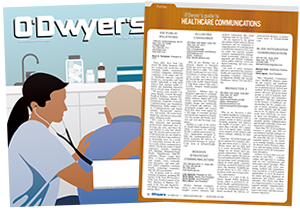 Johnathon Briggs |
These strategies may seem the province of marketers, but as we navigate the ever-shifting landscape of U.S. healthcare, we find our communications toolbox expanding to address this new reality: information finds people as much as people find information.
I’ll say that again: information finds people as much as people find information.
|
|
That’s because technology in the form of faster processing speeds and smaller devices has dramatically changed the way consumers across every industry, including healthcare, access information and connect with the physical and digital world.
Consumer engagement
Nowadays, just about any question we may have about our health is a Google search away. And the digital footprint we leave in the wake of our search (data generated by our web-browsing — think cookies) allows marketers to target us with the right content at the right time to influence what McKinsey & Company describe as our “consumer decision journey.” Most of us have come to accept the way ads follow us around the internet, how the jeans we clicked on but didn’t buy keep popping up here and there even though we left them behind hours (sometimes days) ago.
It’s no wonder then that the healthcare industry continues to invest in the development of online information resources, mobile apps, and personal health devices. As Deloitte’s 2015 Survey of U.S. Health Care Consumers notes: “These tools are designed to increase ‘consumer engagement,’ to help individuals take action to improve their health, make informed decisions, and engage effectively and efficiently with the healthcare system.”
Deloitte survey authors Dr. Harry Greenspun and Gregory Scott highlighted three findings that caught my eye:
52 percent of consumers report searching online for health or care-related information.
Use of social media, patient portals, and performance scorecards is growing. One-quarter of consumers said they looked at a scorecard or report card to compare the performance of doctors, hospitals, or health plans compared to 19 percent in 2013.
Among Millennials who needed medical care, scorecard use grew from 31 percent to 49 percent.
At Public Communications Inc. we gain inspiration from these trends, while recognizing both the opportunities and challenges they signal for our healthcare clients.
Value is the buzzword
We work with clients who are making a positive difference in the world whether they are educating patients about better treatment options, introducing new medicines, sharing important research findings or shattering myths about who gets sick and why. Our clients range from healthcare providers and patient advocacy groups to accrediting organizations and professional associations representing physicians, dentists and allied health professionals.
What each client has in common is the need to communicate value: the health outcome or healthcare benefit achieved for every dollar spent or every policy advanced. We help shape their reputation as thought leaders and providers of choice who are transforming healthcare for the better and delivering innovative solutions.
Value is the buzzword of the moment. Spurred by the Affordable Care Act, the U.S. healthcare industry is shifting from a fee-for-service model where providers are paid by the number of visits and tests they order to a value-based model in which they are incentivized to deliver coordinated care that is cost-effective, keeps people healthy and improves the health of those living with chronic conditions.
This shift requires our clients to develop compelling new messages and content and deliver both in highly targeted ways to various audiences: patients, caregivers, payers, policymakers, media, advocacy organizations and even their own employees or members.
In turn, our clients ask us as communications strategists to demonstrate the value of public relations in a complex, mobile-first world where Gary Grates, Principal of the W2O Group of marketing and communications firms recently noted, “people are tied to platforms, apps, and outlets as a means of filtering information and content that most interests them.”
Bypass the filter
Breaking through today’s fragmented media landscape requires increasingly sophisticated techniques. For example, audience segmentation tools on platforms such as the Google Display Network allow us to identify, target and reach people who may fit a specific psychographic profile or belong to a population that has traditionally been hard to reach or underserved. Pharmacy store apps now send customers reminders as they shop (e.g., a personalized coupon offer for smoking cessation kits based on their historical data and product reviews).
Our agency currently runs a digital campaign on behalf of an AIDS organization that encourages Mexican men in Chicago living with HIV to seek treatment if they are not in care. The campaign delivers culturally specific visuals and messages through websites, Facebook, Instagram and hookup/dating apps. Because the majority of the campaign’s audience uses mobile devices, a click-to-call phone number appears in the ads. When men choose this option, their call is directly routed to a counselor who can connect them to care.
The campaign is continuously reviewed to ensure it drives quality traffic to a central website and prompts action. A phone call or email to the counselor to request care. This assessment of real-time metrics allows us to switch or alter creative — visuals or messages — to optimize what works and avoid wasting resources on what doesn’t. What we’ve learned: Timely and relevant content helps you bypass the filter.
This echoes the Deloitte survey conclusion that healthcare “organizations that figure out how to address their customers’ needs for better informational and digital support may strengthen satisfaction and retention through increased engagement, while also enhancing the value of the services and products they deliver. The trick, however, may be coming up with a set of strategies that will work across the consumer segments that are present in the market. One strategy will not fit all.”
That’s the beauty of the digital world: everything can be tailored.
* * *
Johnathon Briggs, MPH, is Senior Vice President, Digital at Public Communications Inc.



 Lo Isidro, senior director at Real Chemistry with more than a decade of strategic communications and PA experience, has joined Narrative Strategies.
Lo Isidro, senior director at Real Chemistry with more than a decade of strategic communications and PA experience, has joined Narrative Strategies. Nelson Fernandez, former North American chair of APCO Worldwide and managing director of Burson-Marsteller, has joined Volunteers in Medicine Berkshires as director of communications and PA.
Nelson Fernandez, former North American chair of APCO Worldwide and managing director of Burson-Marsteller, has joined Volunteers in Medicine Berkshires as director of communications and PA. Lilit Bargar, who was most recently an EVP in the healthcare practice at Weber Shandwick, comes on board at GCI Health as EVP, corporate practice lead.
Lilit Bargar, who was most recently an EVP in the healthcare practice at Weber Shandwick, comes on board at GCI Health as EVP, corporate practice lead.
 Five ways that successful thought leaders are made.
Five ways that successful thought leaders are made.


 Have a comment? Send it to
Have a comment? Send it to 
No comments have been submitted for this story yet.